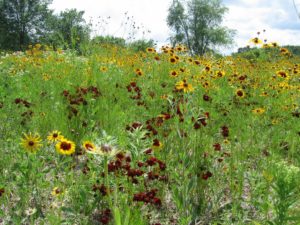Ours has often been a profligate society in using the vast natural resources with which it was originally endowed. We’ve improved our attitudes about conservation, but we have a long way to go. Among those resources we have been prone to waste in the interest of short-term gain has been the deep topsoil that made the Midwest superbly productive. Less than 200 years ago, according to Rick Cruse, an Iowa State University researcher, Iowa had an average of 14 inches of topsoil in which grew thousands of square miles of prairie. Now that soil is about six inches deep, less than half what we inherited—or more accurately, mostly took—from the Native Americans who first lived here.
Those estimates come from an August 12 article in the Chicago Tribune that I shall credit as the inspiration for my addressing this topic. However, those familiar with my first book, Raising Less Corn and More Hell, will be well aware that the topic is not new to me. In 1985, farmer Gary Lamb and I wrote an op-ed for the Des Moines Register decrying the lack of conservation and what it might do in the long term to the fabled productivity of Iowa farmland. In essence, we were saying, nothing lasts forever if we insist on killing the goose that lays the golden egg.
Farmers mostly tore up the prairie to plant the corn, soybeans, wheat, and other agricultural products that now grow on the vast majority of the land in states like Iowa, Illinois, Missouri, and Kansas. Prairie plants had deep roots that held topsoil in place and nurtured it. With prairie grasses removed, loose soil began to erode, clogging streams and rivers that feed the Mississippi River, which dumps its overload into the Gulf of Mexico, producing what has become known as a “dead zone.” This is an area suffering from hypoxia—a shortage of oxygen in the sea that chokes out life. This comes at the additional cost of stripping Midwestern farms of much of the topsoil with which they were originally blessed. We have unhinged that layer of topsoil by depriving it of the prairie root systems that once anchored it. In fact, we continue to do so.
But the problem is more serious and immediate than simply undermining the long-term productivity of the soil. Current practices also threaten the public health and welfare of people in states like Iowa. Not long ago, the Des Moines Water Works filed suit against three upstream counties for failing to control the nonpoint source runoff that is contaminating the capital city’s water supply. That suit is being met with a good deal of anger and skepticism, but it is symptomatic of a larger conflict. That conflict pits the priorities of agriculture versus public welfare, a dispute playing out in other forms in even larger venues like California. But there the issue often has more to do with drought and the protection of adequate water supplies than with polluted runoff. In Iowa, floods have been a more persistent danger in recent memory.
Lawsuits, however, are not the only rational response to such a major public policy problem. It is critical that public universities support research aimed at viable solutions, and at least some research at Iowa State University is pointing to an answer that should seem remarkably obvious: restore the prairie. The imperatives of modern food production may make it clear that we are not going to restore all the farmland in the Midwest to pre-modern conditions. But the prairie provides demonstrable ecological benefits that we can ignore only at the cost of prolonging current problems with flooding and water quality. In a sense, what we are learning about the value of restoring some prairie for the purpose of reducing runoff and improving downstream water quality is similar to what we are learning in more urban contexts about the value of green infrastructure—the urban forest, the green roofs, the living shorelines, and other nature-based features that enhance the environmental quality of our communities.
But green infrastructure is not a concept that need be limited to our urban areas. Nature provides vast ecological functions for human benefit in all sorts of settings if we are wise enough to investigate them and learn to use them.
In that sense, I think that Iowa State University is on to something. Researchers there have been demonstrating the value of prairie restoration with a project called Science-based Trials of Rowcrops Integrated with Prairie Strips (STRIPS). Test sites have shown not only that these prairie strips can capture much of the polluted runoff from farms and enrich the soil, but that they provide valuable habitat for birds and other wildlife, restoring some of the richness of the land in the process. For instance, one research project by Lisa Schulte and others showed that such treatments doubled or tripled the presence of bird species, both in overall abundance and variety. Other research has found that wider strips of prairie serve to trap greater levels of sediment that would otherwise clog streams and reduce water quality. It is as if, having been blind to the free benefits of natural systems for so long, we have at last begun to learn to sing nature’s tune anew.
But it will take time to change attitudes and perspectives in a farm sector that has often been rather conservative about adopting such techniques. There is still likely to be a lively debate between environmentalists and dominant sectors of the agricultural industry, with varying levels of resonance in different states, but results speak volumes and gradually help to change minds. There may be more lawsuits like the one that originated in Des Moines, and there may ultimately be some meaningful legislative debates about incentives and regulations. We can at least hope that the steady infusion of research-based information on the benefits of prairie restoration will make a difference soon enough to matter. There is certainly a great deal at stake.
Jim Schwab

Trackbacks/Pingbacks